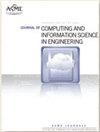基于预训练图像识别模型的离心泵浅学习阻塞检测的模糊递归图
IF 2.6
3区 工程技术
Q2 COMPUTER SCIENCE, INTERDISCIPLINARY APPLICATIONS
Journal of Computing and Information Science in Engineering
Pub Date : 2023-04-27
DOI:10.1115/1.4062425
引用次数: 0
摘要
碎布、灰尘、外来颗粒等是造成离心泵堵塞和性能下降的主要原因。本研究详细阐述了一种实验和数据驱动的方法来识别吸入、排出和同时发生的两种阻塞。利用CEEMD对放电压力信号进行采集和去噪。利用Xception、GoogleNet和Inception三种预训练模型对去噪后的模糊递归图进行分类。这些模型都没有在这些图像上进行训练,因此,从不同的池化层中提取特征,其中也包括浅特征。从不同层提取的特征被馈送到四个浅学习分类器:二次支持向量机、加权KNN、窄神经网络和子空间判别分类器。研究发现,使用Xception模型的二次池化特征训练子空间判别器,准确率达到97.8%。此外,该方法还适用于泵的其他堵塞情况。子空间判别分析优于其他选择的浅分类器,从Xception模型的第一个池化层提取的特征的准确率为93%。因此,本研究展示了一种使用预训练和浅层分类器识别泵堵塞的有效方法。本文章由计算机程序翻译,如有差异,请以英文原文为准。
Fuzzy Recurrence Plots for Shallow Learning-Based Blockage Detection in a Centrifugal Pump Using Pre-Trained Image Recognition Models
Rags, dusts, foreign particles etc. are primary cause of blockage in centrifugal pump and deteriorates the performance. This study elaborates an experimental and data-driven methodology to identify suction, discharge and simultaneous occurrence of both blockages. The discharge pressure signals are acquired and denoised using CEEMD. The fuzzy recurrence plots obtained from denoised signals are attempted to classify using three pre-trained models: Xception, GoogleNet and Inception. None of these models are trained on such images, thus, features are extracted from different pooling layers which include shallow features too. The features extracted from different layers are fed to four shallow learning classifiers: Quadratic SVM, Weighted KNN, Narrow Neural network, and subspace discriminant classifier. The study finds that subspace discriminant achieves highest accuracy of 97.8% when trained using features from second pooling of Xception model. Furthermore, this proposed methodology is implemented at other blockage condition of the pump. The subspace discriminant analysis outperforms the other selected shallow classifier with an accuracy of 93% for the features extracted from the first pooling layer of the Xception model. Therefore, this study demonstrates an efficient method to identify pump blockage using pre-trained and shallow classifiers.
求助全文
通过发布文献求助,成功后即可免费获取论文全文。
去求助
来源期刊
CiteScore
6.30
自引率
12.90%
发文量
100
审稿时长
6 months
期刊介绍:
The ASME Journal of Computing and Information Science in Engineering (JCISE) publishes articles related to Algorithms, Computational Methods, Computing Infrastructure, Computer-Interpretable Representations, Human-Computer Interfaces, Information Science, and/or System Architectures that aim to improve some aspect of product and system lifecycle (e.g., design, manufacturing, operation, maintenance, disposal, recycling etc.). Applications considered in JCISE manuscripts should be relevant to the mechanical engineering discipline. Papers can be focused on fundamental research leading to new methods, or adaptation of existing methods for new applications.
Scope: Advanced Computing Infrastructure; Artificial Intelligence; Big Data and Analytics; Collaborative Design; Computer Aided Design; Computer Aided Engineering; Computer Aided Manufacturing; Computational Foundations for Additive Manufacturing; Computational Foundations for Engineering Optimization; Computational Geometry; Computational Metrology; Computational Synthesis; Conceptual Design; Cybermanufacturing; Cyber Physical Security for Factories; Cyber Physical System Design and Operation; Data-Driven Engineering Applications; Engineering Informatics; Geometric Reasoning; GPU Computing for Design and Manufacturing; Human Computer Interfaces/Interactions; Industrial Internet of Things; Knowledge Engineering; Information Management; Inverse Methods for Engineering Applications; Machine Learning for Engineering Applications; Manufacturing Planning; Manufacturing Automation; Model-based Systems Engineering; Multiphysics Modeling and Simulation; Multiscale Modeling and Simulation; Multidisciplinary Optimization; Physics-Based Simulations; Process Modeling for Engineering Applications; Qualification, Verification and Validation of Computational Models; Symbolic Computing for Engineering Applications; Tolerance Modeling; Topology and Shape Optimization; Virtual and Augmented Reality Environments; Virtual Prototyping

 求助内容:
求助内容: 应助结果提醒方式:
应助结果提醒方式:


